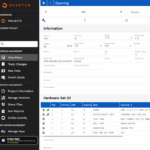 I’ve thought about this question before, but I finally asked the US Access Board…
I’ve thought about this question before, but I finally asked the US Access Board…
Is a surface-mounted automatic door bottom compliant with the accessibility standards?
Both the ADA Standards for Accessible Design and ICC A117.1 Accessible and Usable Buildings and Facilities require manually-operated doors to have a flush smooth surface on the push side, measured 10 inches up from the floor. There are a few exceptions for sliding doors, some all-glass doors, and doors that don’t extend to within 10 inches of the floor or ground (see this Decoded article for more info). Note that this requirement does not apply to automatic doors.
Where there are horizontal or vertical joints in the surfaces of the door in this area, each of the surfaces must be within 1/16 inch of the same plane. The intent is to prevent a wheelchair footpad, crutch, or cane from being caught on protruding hardware, glass bead, a recessed panel, etc. With a flush, smooth surface, these mobility aids will slide along the face of the door as the building occupant is opening the door manually.
When a pair of doors has panic hardware, a surface-mounted vertical rod and latch at the bottom of the door will not comply with the accessibility requirement for a flush, smooth surface. Therefore, these doors may be equipped with concealed vertical rod panic hardware if a removable mullion is not desired. If the doors are also equipped with automatic door bottoms, a concealed unit will conflict with the concealed vertical rod panic hardware (or flush bolts). Using a surface-mounted automatic door bottom might seem like a good way to avoid this conflict, but the door bottom would mount on the push side of the door, in the area that is required to be flush and smooth.
I spoke to a staff member from the US Access Board, to discuss whether a surface-mounted automatic door bottom – which runs along the entire door width – would create a potential catch-point for a crutch, cane, or wheelchair footpad. The interpretation of the US Access Board was that the surface-mounted automatic door bottom would not comply with the requirement of the accessibility standards because it would create a surface that is not within 1/16 inch of the other surface – the face of the door.
Have you run into this conflict before? What’s the best solution?
You need to login or register to bookmark/favorite this content.





Lori, silly question. Why can’t mount the surface auto door bottom at pull side?
-David Gong
Hi David –
That’s a good question. The products that are currently available (as far as I know) have to be mounted on the push side because the triggers that drop the seal need to come into contact with the jambs of the frame – one or both sides depending on the design.
– Lori
When I was working,we could not use surface automatic door bottoms on commercial projects, residential only
Use concealed auto door bottoms and if using vertical rods, they must have the LBR feature. If exit devices are not required, there are “top bolt only” flushbolt configurations.
On such a wooden door I believe a concealed mortised automatic door bottom that is recessed into a dado in the bottom rail, like Pemko #STC411 would be code compliant.
Hi Pete –
The problem is that the concealed automatic door bottom will conflict with other concealed hardware – like concealed vertical rod panic hardware, or flush bolts.
– Lori
Yes, I have run into this interpretation before. In fact, I have even had one ADA Consultant tell me that the screw heads on an armored kick plate fastened to the face of door violated the ADA because they (the screw heads) protruded from the surface of the door.
Would it be compliant if the flush door bottom’s housing extended above the 10″ mark as a single, smooth unit?
In my opinion, yes, that would comply with the accessibility standards.
– Lori
The solution is in manufacturing, make the automatic door bottom 10 inches like a kick plate. I want royalties on this idea.
Hi Joe –
I have thought about that too, and someone else commented about a wood “filler” that extends the ADB up to 10 inches. I think the problems would be push-back from the architect regarding the aesthetics, and the cost of creating the product when the usage is relatively low.
– Lori
I too have had several IRO’s tell me that the screw heads, (that are supplied by the manufacturers) are against the code, even though those are the screws that the armor plates have been tested with for labeling purposes. I have been told that I need to use flush head screws and have the screws sit countersunk and flush with the surface of the armor plate. I have asked how even with a slight head flat head screw with the thin thickness gauge of an armor plate how to countersink and install a flush head screw. Has anybody heard of or dealt with that kind of issue before?
This was on a large hospital, with many armour plates on rated.
Would the intended purpose of the rules not be satisfied if they were to modified to specify that for any two points in the bottom 10″ of the door separated by distance d, the distances between those points and the main plane of the door must be within d/4 + 1/16″, effectively allowing projections so long as they were sufficiently shallowly sloped as not to not snag objects like canes or wheels?
I would think that for things like fire doors were cutting into a door to install hardware within it would void the rating, it would be helpful to have fire doors include threaded inserts, and have a recognized category of hardware that could be safely surface-mounted to a fire door that has the right inserts (without affecting the door’s rating), but for that to work it would be necessary to have the rules allow for surface-mounted hardware. Would you see any downside to such allowance?
Hi John –
That would be an interesting idea, but if you are saying that the inserts would be part of the door construction it would require some coordination. And a door manufacturer willing to fire test it.
– Lori
Agreed, avoid bottom rods like the plague. And, don’t use a fully concealed door bottom–very very difficult to reach when it breaks.
When ordering new hollow metal doors you can order semi-mortise drop bottom preps on the door. That way the surface counted drop bottom ends up flush with the face of the door. much easier to replace when needed
Thanks Luis – Have these held up well in your experience?
– Lori
They do if you use them with a threshold or this activates on a smooth epoxy floor.